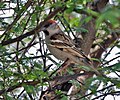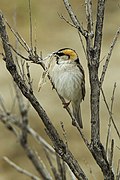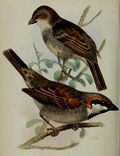| Image | Common name | Scientific name | Distribution |
|---|
 | Cape sparrow | Passer melanurus | central coast of Angola to eastern South Africa and Swaziland |
 | Chestnut sparrow | Passer eminibey | Darfur in Sudan to Tanzania |
| Kordofan sparrow | Passer cordofanicus | South Sudan and Chad |
 | Shelley's sparrow | Passer shelleyi | eastern Africa from South Sudan, southern Ethiopia, and north-western Somalia to northern Uganda and north-western Kenya |
 | Kenya sparrow | Passer rufocinctus | Kenya and Tanzania |
 | Great sparrow | Passer motitensis | southern Africa |
 | Northern grey-headed sparrow | Passer griseus | tropical Africa |
 | Swainson's sparrow | Passer swainsonii | northeastern Africa |
 | Swahili sparrow | Passer suahelicus | southern Kenya and Tanzania |
 | Parrot-billed sparrow | Passer gongonensis | eastern Africa |
 | Southern grey-headed sparrow | Passer diffusus | Angola and Zambia southwards into South Africa |
 | Sind sparrow | Passer pyrrhonotus | Indus valley region in South Asia |
 | Russet sparrow | Passer cinnamomeus | southeastern Tibet, Bhutan, Sikkim, Nepal, Uttarakhand, and Himachal Pradesh to Kashmir and Nuristan in Afghanistan, as well as China, Korea, and Japan |
 | Eurasian tree sparrow | Passer montanus | Temperate Eurasia and Southeast Asia. Introduced in Sardinia, eastern Indonesia, the Philippines, Micronesia, Victoria and New South Wales in Australia and the U.S. states of Missouri, Illinois and Iowa. |
 | Saxaul sparrow | Passer ammodendri | Central Asia |
 | Plain-backed sparrow | Passer flaveolus | Myanmar to central Vietnam, and south to the western part of Peninsular Malaysia |
 | Abd al-Kuri sparrow | Passer hemileucus | Abd al Kuri in the Socotra archipelago |
 | Socotra sparrow | Passer insularis | islands of Socotra, Samhah, and Darsah |
 | Spanish sparrow | Passer hispaniolensis | Mediterranean region, Macaronesia and south-west and central Asia |
 | Italian sparrow | Passer italiae | northern and central Italy, Corsica, and small parts of France, Switzerland, Austria, and Slovenia |
 | House sparrow | Passer domesticus | Middle East, Eurasia and parts of North Africa. Introduced in subarctic North America, southern South America, southern Africa, eastern Australia, New Zealand and Hawaii |
 | Somali sparrow | Passer castanopterus | northern Somalia, Djibouti, Ethiopia and Kenya. |
 | Iago sparrow | Passer iagoensis | archipelago of Cape Verde |
 | Desert sparrow | Passer simplex | Sahara Desert of northern Africa |
 | Zarudny's sparrow | Passer zarudnyi | Uzbekistan and Turkmenistan |
 | Arabian golden sparrow | Passer euchlorus | south west Arabia and also the coast of Somalia and Djibouti |
 | Sudan golden sparrow | Passer luteus | sub-Saharan Africa |
 | Dead Sea sparrow | Passer moabiticus | Middle East and another in western Afghanistan and eastern Iran |
|






























